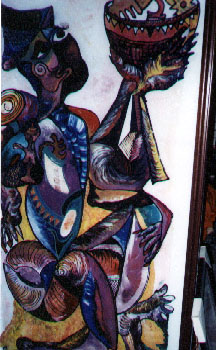
Painting by local
merchant and artist Aziz
|
The cultural influence and small
businesses present in the community is neither new, nor surprising.The
concept of offering an intimiate mixed residential and business district
was planned over sixtyyears ago. Real estate developer Walter H. Leimert
began this community with a purchase of 240 acres of land then known as
Rancho Cienga O Pao de la Tijera in the 1920s. The architectural firm Olmsted
and Olmsted, who created New York City’s massive Central Park, developed
the area into mixed residential dwellings, a commercial center, a school
and a park plaza. In 1947 the Baldwin Hills Plaza, the first indoor shopping
mall in Los Angeles and one of the earliest in the nation, was completed
adjacent to the Leimert Park Village located on the opposing side of Crenshaw
Boulevard.
Today the Village is the oldest of
five real estate divisions that have coexist as closely woven communities.
Baldwin Hills Estates, Baldwin Hills, View Park and Windsor Hills are the
four surrounding, mostly middle-class, larger, family styled residences,
which are linked to Leimert Park Village by bounds of physical location,
racial demographics and local cultural history. An irony of
Leimert Park’s historic cultural
and economic struggle as a site for Afro-centric business is that it is
located among more affluent, predominately African-American neighborhoods.
This is illustrated in an article entitled "The Crenshaw Area is L.A.’s
Most Affluent Black Community, Yet it Suffers from
Serious Decay," from the L.A. Times. |
